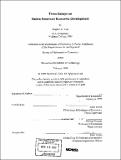| dc.contributor.advisor | Peter Temin and Michael Kremer. | en_US |
| dc.contributor.author | Colt, Stephen G. (Stephen Goodwin), 1959- | en_US |
| dc.date.accessioned | 2005-08-19T19:19:29Z | |
| dc.date.available | 2005-08-19T19:19:29Z | |
| dc.date.copyright | 1999 | en_US |
| dc.date.issued | 1999 | en_US |
| dc.identifier.uri | http://hdl.handle.net/1721.1/9668 | |
| dc.description | Thesis (Ph.D.)--Massachusetts Institute of Technology, Dept. of Economics, 1999. | en_US |
| dc.description | Includes bibliographical references. | en_US |
| dc.description.abstract | I explore the recent attempts of Alaska Natives and American Indians to achieve self-determined economic progress by exploiting one-time, group-based wealth transfers. The results suggest caution when using such transfers as development tools. In Essays one and two, I analyze the Alaska Native Claims Settlement Act of 1971 (AN CSA), which transferred 44 million acres of land and 1 billion dollars to Alaska Native business corporations. After adjustment for windfall tax preferences and natural resource asset sales the 12 regional corporations lost 80 percent of their cash endowment -- about $380 million -- in business operations between 1973 and 1993. The corporations channeled resources toward investment, but the investment was not productive. Behind the poor average performance lies much cross-sectional variation which I explore using models from development theory and political economy. In a multi-sector framework, local business ventures based on the traditional economy earned positive returns, but were limited by small markets. Statewide enterprises made persistent losses of more than 20% per year. Oil investments produced mixed results. Joint ventures with non-Native firms performed better than wholly owned operations. Quasirents from Native employment were important to three firms -- the rest lost money without any countervailing employment. Case history evidence suggests that internal sharing networks and common preferences helped the high-employment firms to deliver both jobs and dividends. Overall, most variation in performance remains unexplained. In Essay three I estimate the welfare effects of reservation-based high-stakes bingo on individual American Indians, using differences-in-differences techniques applied to U.S. census microdata from 1980 and 1990. The economic decline of one large non-gaming tribe generates spurious average treatment effects. When this tribe is removed from the data the average gains to bingo-area Indians in hours worked, income, and poverty status are plausible but insignificant. Using bingo revenue as a measure of treatment intensity I find modest and significant positive effects of bingo revenue on hours worked and income. Using white people as additional controls corroborates these results and highlights the economic decline of Indians relative to whites. Against this decline any gains from bingo are small. | en_US |
| dc.description.statementofresponsibility | by Stephen G. Colt. | en_US |
| dc.format.extent | 179 p. | en_US |
| dc.format.extent | 16626029 bytes | |
| dc.format.extent | 16625788 bytes | |
| dc.format.mimetype | application/pdf | |
| dc.format.mimetype | application/pdf | |
| dc.language.iso | eng | en_US |
| dc.publisher | Massachusetts Institute of Technology | en_US |
| dc.rights | M.I.T. theses are protected by copyright. They may be viewed from this source for any purpose, but reproduction or distribution in any format is prohibited without written permission. See provided URL for inquiries about permission. | en_US |
| dc.rights.uri | http://dspace.mit.edu/handle/1721.1/7582 | |
| dc.subject | Economics | en_US |
| dc.title | Three essays on Native American economic development | en_US |
| dc.title.alternative | 3 essays on Native American economic development | en_US |
| dc.type | Thesis | en_US |
| dc.description.degree | Ph.D. | en_US |
| dc.contributor.department | Massachusetts Institute of Technology. Department of Economics | |
| dc.identifier.oclc | 42463497 | en_US |
